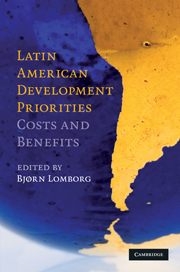Book contents
- Frontmatter
- Contents
- List of figures
- List of tables
- List of contributors
- Acknowledgments
- Abbreviations and acronyms
- Expert panel findings
- Introduction
- Democracy
- Education
- Employment and social security
- Environment
- 4 Forests, biodiversity, and avoided deforestation in the LAC region
- 4.1 Forests and biodiversity: an alternative view
- Fiscal problems
- Health
- Infrastructure
- Poverty
- Public administration
- Violence and crime
- Conclusion
- References
4.1 - Forests and biodiversity: an alternative view
Published online by Cambridge University Press: 05 June 2012
- Frontmatter
- Contents
- List of figures
- List of tables
- List of contributors
- Acknowledgments
- Abbreviations and acronyms
- Expert panel findings
- Introduction
- Democracy
- Education
- Employment and social security
- Environment
- 4 Forests, biodiversity, and avoided deforestation in the LAC region
- 4.1 Forests and biodiversity: an alternative view
- Fiscal problems
- Health
- Infrastructure
- Poverty
- Public administration
- Violence and crime
- Conclusion
- References
Summary
Introduction
The LAC region faces a number of major environmental challenges, including climate change, loss of biodiversity, provision of clean drinking water, deteriorating air quality in urban areas, and over-fishing of economically important fisheries. Roger Sedjo and Juha Siikamäki's study (2007) focuses on one of these issues – biodiversity in the region's forests. Fueled by population growth in the developing world and increased resource demands in both the developed and developing regions, the loss of forests and forest biodiversity has accelerated in many parts of the world. These issues are particularly acute in tropical forests, which also contain many of the world's biodiversity “hot spots.” Forest fragmentation, deforestation, and overutilization of residual forests have impacted the diversity of remaining species.
This has prompted international efforts to protect the remaining tropical forests, but conservation remains significantly under-funded. In the developing world, current expenditures have been estimated to be only a small fraction of what is needed to ensure the survival of representative species, habitats, and ecosystems (Balmford et al. 2003; Kramer 2007).
This alternative view provides a summary of some of the main points raised in chapter 4's assessment of LAC biodiversity issues and opportunities. Some additional economic information is introduced, and an alternative, more modest solution for addressing the region's biodiversity concerns is provided, based on an expansion of protected areas using international cost-sharing.
- Type
- Chapter
- Information
- Latin American Development PrioritiesCosts and Benefits, pp. 227 - 234Publisher: Cambridge University PressPrint publication year: 2010



